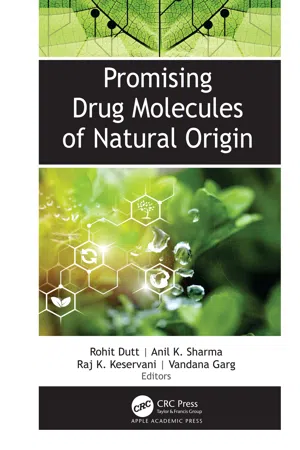1.1 INTRODUCTION
Nowadays, renewed interests in medicinal plants have been increased due to the wide range of highly complex secondary metabolites. Plants play a beneficial role as a folk medicine, food supplements, and nutraceuticals, in modern medicines, synthesis of chemical entities and pharmaceutical intermediates (Pandey et al., 2014). Though there are numerous advantages of herbal medicines being easily available, cost-effective, range-wide range of medicinal uses, this leads to the growing demand in the International market as well. Now most of the medicinal herbs are commercialized in markets as processed or modified forms such as tablets, capsules, powders, and in dried material (Veldman et al., 2014; Kool et al., 2012). To meet this growing demand and to decrease the non-availability of the herbal drugs they are being adulterated with substandard material, that’s the main reason for the withdrawal of various herbal drug formulations from the International market. However, spurious, substituted, and adulterated medicines put the life of consumers in danger (Ize Ludlow et al., 2004; Skalli et al., 2002; Ouarghidi 2012). Adulteration is a common practice of addition, substitution, sophistication, spoilage, and inferiority either done intentionally or by mistake. Seasonal (time of collection) and chemotypes (composition of the secondary metabolites) variation, of the plants used in the commercialized herbal formulation is another important issue (Chanda et al., 2014). It is found that the long-term usage of herbal medicines shows some side effects which refute the safety consideration of herbal medicines. Aloe has attained the seventh position as the most widely used herb in the world in the treatment of minor bruises. Now its internal usage has been increased which in the long term causes potassium deficiency. Anthraquinones glycosides containing drugs should not be taken for more than 2 weeks as these may cause an electrolyte imbalance. This review highlights different standardization parameters and measures for the quality control of herbal medicine.
The term “standardization” may be defined as a set of information, which is necessary to control the reasonable consistency of products. Inherent variation attained by different agriculture and manufacturing process can also be assured qualitatively by the process of standardization (Chanchal et al., 2016). Methods of standardization include all parameters that contribute to their identity, efficacy, and quality of herbal drugs. Correct identification of the sample, morphological, and pharmacognostic evaluation such as the presence of volatile matter, quantitative evaluation (ash values, extractive values, moisture content, etc.), phytochemical evaluation, test for the presence of xenobiotics, microbial load testing, toxicity testing, and biological activity are the various parameters taking into considerations.
Amongst these, the phytochemical profile has a special significance since, it bears a direct effect on the activity of the herbal drugs. Preliminary steps for standardization of crude drugs include pharmacognostical study, which provides all the valuable information regarding the physical appearance and chemical constituent of the crude drug. It also provides various parameters, which help in identifying adulteration in dry powder, because when a plant gets dried and powdered it loses its morphological identity and easily prone to adulteration (Chanda et al., 2014). Current quality and authentication assessment methods mainly based on morphology and analytical phyto-chemistry based methods are detailed in different pharmacopeias (Raclariu et al., 2018). An error in the identification of vernacular name, quantification organoleptic, physical, chemical, and microbiological parameters will lead to sub standardization of herbal medicines and formulation which eventually affect the health of consumers. Recently advances are made on molecular techniques to detect substitution and adulteration in medicinal plants. Detection of adulteration is even possible in processed forms (Coghlan et al., 2012; Newmaster et al., 2013).
The following are the steps involved in the standardization of raw materials, and their formulations if we want to check its identity, purity, and quality.
1.2 AUTHENTICATION OF PLANTS
It involves the taxonomical botanical identification of crude drugs as prescribed in the official pharmacopeias. Plant name should be written in Latin words, where the first letter represents the Genus of the plant while the second one is a species (both in italics font) sometimes followed by varieties of the plant. Like in the case of broccoli and cabbage, both these vegetables have the same botanical name, i.e., Brassica oleracea but are of different varieties as the former one is of italica and later is capitata. So, the plant which is to be identified should be fully authenticated with the help of references given in the Pharmacopoeia or on the basis of their morphological and microscopical characters.
If the morphology of the two plants is quite similar and it is hard to distinguish or identify them even for an expert then DNA bar-coding is found to be helpful. DNA bar-coding in combination with High Resolution Melting analysis (Bar HRM) is an effectual, way to precisely identification of species in plants. Chloroplast DNA (cpDNA) is another suitable method used in the identification of plants (Kress et al., 2005). There is a region in the chloroplast genome of each plant species which show sufficient variation that will be convenient for identification. The CBOL Plant Working Group have studied about 907 plant species by using a variety of different gene and non-gene regions in the cpDNA and found that the two regions, rbcL, and matK, exhibit a promising efficient role in the discrimination in plant species (CBOL Plant Working Group, 2009). The greatest advantage of DNA metabarcoding is its ability to identify every single species within complex multi-ingredient and processed mix...
